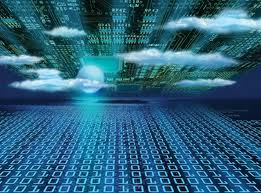| GREEN COMPUTING |
INRODUCTION:
Green computing or green IT, refers to environmentally sustainable computing . In the article Harnessing Green IT: Principles and Practices, San Murugesan defines the field of green computing as “the study and practice of designing, manufacturing, using, and disposing of computers, servers, and associated subsystems—such as monitors, printers, storage devices, and networking and communications systems—efficiently and effectively with minimal or no impact on the environment.” The goals of green computing are similar to green chemistry. They blackuce the use of hazardous materials, maximize energy efficiency during the product’s lifetime, and promote the recyclability or biodegradability of defunct products and factory wastes. Research continues in the key areas such as making the use of computers as energy-efficient as possible, and designing algorithms and systems for efficiency-related computer technologies.
Supercomputers provide an unparallel level of computational horsepower for solving challenging problems across a wide spectrum of fields—from scientific inquiry, engineering design, and financial analysis to national defense and disaster pblackiction—such horsepower usually comes at the expense of enormous power consumption, not only to run the supercomputer but also to cool it. This, in turn, results in extremely large electricity bills and blackuced system reliability. Accordingly, the HEC research community started exploring green supercomputing as away to achieve autonomic energy and power savings with little to no impact on performance.More directly it means using computers in ways that save the environment, save energy and save money.
DOES MY COMPUTER POLLUTE?
It may. Computers can harm the environment and cost us money in a variety of ways. For example, if you have a CRTmonitor, an older computer, or if your computer is not set to use power wisely, it may pollute.
THE U OF A DOESN’T POLLUTE, DOES IT?
It does, and IT is partially to blame.Universities likely produce more carbon dioxide emissions than the aviation industry, and about one third to one half of those emissions come from IT. IT-related pollution at the U of A is caused by many of the reasons individuals’ home computers pollute.
EFFECT OF COMPUTERS ON ENVIRONMENT:
a) Further environmental problems caused by computers include a large amount of energy consumption during the production of computers as well as by the use of computers. “For the manufacturing of a normal PC approx. 30’000 megajoules of energy is used.”
b) Harmful effects caused by improper computer & electronic waste recycling:
Electronic waste affects nearly every system in the human body because they contain a plethora of toxic components including Mercury, Lead, Cadmium, Polybrominated Flame Retardants, Barium and Lithium. Even the plastic casings of electronic products contain Polyvinyl Chloride. The health effects of these toxins on humans include birth defects, brain, heart, liver, kidney and skeletal system damage. They will also significantly affect the nervous and reproductive systems of the human body.
All these toxins are persistent, bioaccumulative toxins (PBTs) that create environmental and health risks when computers are incinerated, put in landfills or melted down. When computers monitors and other electronics are burnt, they create cancer-producing dioxins which are released into the air we breathe. If electronics are thrown in landfills, these toxins may leach into groundwater affecting your local community.
c) Many people suppose that computers are environmentally benign. Silicon valley may be badly polluted, but the product itself seems not to disrupt nature on anything like the scale of, for example, automotive technology. Computers may even have certain environmental advantages. They are at least alleged to save paper. And, by keeping us glued for long periods of our lives to video display terminals, they might even keep us out of mischief, since nature is usually the loser when we manage to tear ourselves away from our electronic lives for some real-time interaction.
d)Electronic waste, e-waste, e-scrap, or waste electrical and electronic equipment (WEEE) describes discarded electrical or electronic devices. There is a lack of consensus as to whether the term should be applied to resale, reuse, and refurbishing industries, or only to those products that cannot be used for its intended purpose. Informal processing of electronic waste in developing countries may cause serious health and pollution problems, though these countries are also most likely to reuse and repair electronics. Some electronic scrap components, such as CRTs, may contain contaminants such as lead, cadmium, beryllium, or brominated flame retardants. Even in developed countries recycling and disposal of e-waste may involve significant risk to workers and communities and great care must be taken to avoid unsafe exposure in recycling operations and leaching of material such as heavy metals from landfills and incinerator ashes.
Electronic waste is often exported to developing countries.[1]
APPROACHES FOR GREEN COMPUTING:
PRODUCT LANGEVITY:
Gartner maintains that the PC manufacturing process accounts for 70% of the natural resources used in the life cycle of a PC. More recently, Fujitsu released a Life Cycle Assessment (LCA) of a desktop that show that manufacturing and end of life accounts for the majority of this laptop ecological footprint. Therefore, the biggest contribution to green computing usually is to prolong the equipment’s lifetime. Another report from Gartner recommends to “Look for product longevity, including upgradability and modularity.” For instance, manufacturing a new PC makes a far bigger ecological footprint than manufacturing a new RAM module to upgrade an existing one.
BETTER USAGE OF MATERIAL BY COMPANIES:
Due to new research and growing public awareness about the effects of these hazardous materials, many companies are beginning to research and are finding new ways to build greener PCs that do not make use of these dangerous chemicals. Most companies have completely eliminated CRT monitors from their product line altogether, since they emit toxic radiation and can contain many toxic phosphors. Though LCD screens have taken their place, many of these also contain toxic materials.
DATA CENTER DESIGN:
Data center facilities are heavy consumers of energy, accounting for between 1.1% and 1.5% of the world’s total energy use in 2010 .The U.S. Department of Energy estimates that data center facilities consume up to 100 to 200 times more energy than standard office buildings.Energy efficient data center design should address all of the energy use aspects included in a data center: from the IT equipment to the HVAC equipment to the actual location, configuration and construction of the building.The U.S. Department of Energy specifies five primary areas on which to focus energy efficient data center design best practices:
- Information technology (IT) systems
- Environmental conditions
- Air management
- Cooling systems
- Electrical systems
TERMINAL SERVERS:
Terminal servers have also been used in green computing. When using the system, users at a terminal connect to a central server; all of the actual computing is done on the server, but the end user experiences the operating system on the terminal. These can be combined with thin clients, which use up to 1/8 the amount of energy of a normal workstation, resulting in a decrease of energy costs and consumption. There has been an increase in using terminal services with thin clients to create virtual labs. Examples of terminal server software include Terminal Services for Windows and the Linux Terminal Server Project (LTSP) for the Linux operating system.
REPLACE A CRT MONITOR WITH A LCD MONITOR:
LCD monitors can use one-half to two-thirds the energy of a CRT monitor. Flat screen monitors also result in less eye-strain.[2]
Turn off your computer when you will not be using it for several hours[3]
Leaving your computer turned on overnight for a year generates about 920 lbs. of CO2 . Yet, research indicates that as many of 60% of workers using computers do not always shut them down at the end of the day. (Wasting Energy While We Sleep)
New technologies make this easier!
Enabling users to turn off their computers at the end of the day is a viable way to decrease related energy costs by 60%. Network administrators can now purchase cost-effective hardware and software (W0L)that enables them to perform software and security updates, as necessary. The payback period for network software to enable updates to turned-off computers can be less than one year.Wasted energy, unnecessary utility bills, and increased pollution make turning off your computer at the end of your workday an easy way to blackuce the University’s environmental footprint
Enabling users to turn off their computers at the end of the day is a viable way to decrease related energy costs by 60%. Network administrators can now purchase cost-effective hardware and software (W0L)that enables them to perform software and security updates, as necessary. The payback period for network software to enable updates to turned-off computers can be less than one year.Wasted energy, unnecessary utility bills, and increased pollution make turning off your computer at the end of your workday an easy way to blackuce the University’s environmental footprint
POWER MANAGEMENT:
There is a significant market in third-party PC power management software offering features beyond those present in the Windows operating system. available. Most products offer Active Directory integration and per-user/per-machine settings with the more advanced offering multiple power plans, scheduled power plans, anti-insomnia features and enterprise power usage reporting. Notable vendors include 1E NightWatchman, Data Synergy PowerMAN (Software), Faronics Power Save and Verdiem SURVEYOR
Energy–performance trade-off. For certain workloads, we can scale down the processor to save 20 percent in energy costs while losing only 5 percent in performance. This 5 percent loss means that an application that normally takes 57 minutes to run would take one hour but would have a 20 percent blackuction in energy consumption, which translates to $2 million in energy savings.
MATERIAL RECYCLING:
Recycling computing equipment can keep harmful materials such as lead, mercury, and hexavalent chromium out of landfills, and can also replace equipment that otherwise would need to be manufactublack, saving further energy and emissions.[4]Computer systems that have outlived their particular function can be re-purposed, or donated to various charities and non-profit organizations[5]. However, many charities have recently imposed minimum system requirements for donated equipment. Additionally, parts from outdated systems may be salvaged and recycled through certain retail outlets and municipal or private recycling centers. Computing supplies, such as printer cartridges, paper, and batteries may be recycled as well.
CONCLUSION:
Computer usage generates a great deal of paper. Minimize unnecessary waste by double-checking documents for accuracy before printing and maximizing use of correspondence via email or electronic copy rather than hard copy. Utilize the computer efficiently by concentrating blocks of time for use and keeping the hardware off when not in use. Operate Energy Star labelled equipment in the office whenever possible. Engage the power management features on your computers to allow the screens and hard drivesto become inactive after several minutes of being idle.
Green computing is no longer just a white-wash expression, as government schemes like the Carbon blackuction Commitment (CRC) scheme, the Climate Change Agreement (CCA) or the European Union Emission Trading Scheme (EU ETS), are encouraging companies to revaluate their use of IT resources. Finding new ways of improving energy efficiency is no longer a boardroom discussion, but a reality for many UK businesses.
This guide has been designed to help you improve overall energy efficiency, within the IT department, and implement the right green technology for your business.
This green technology guide covers green computing, government legislation and energy efficiency.
 Binary Cipher
Binary Cipher
